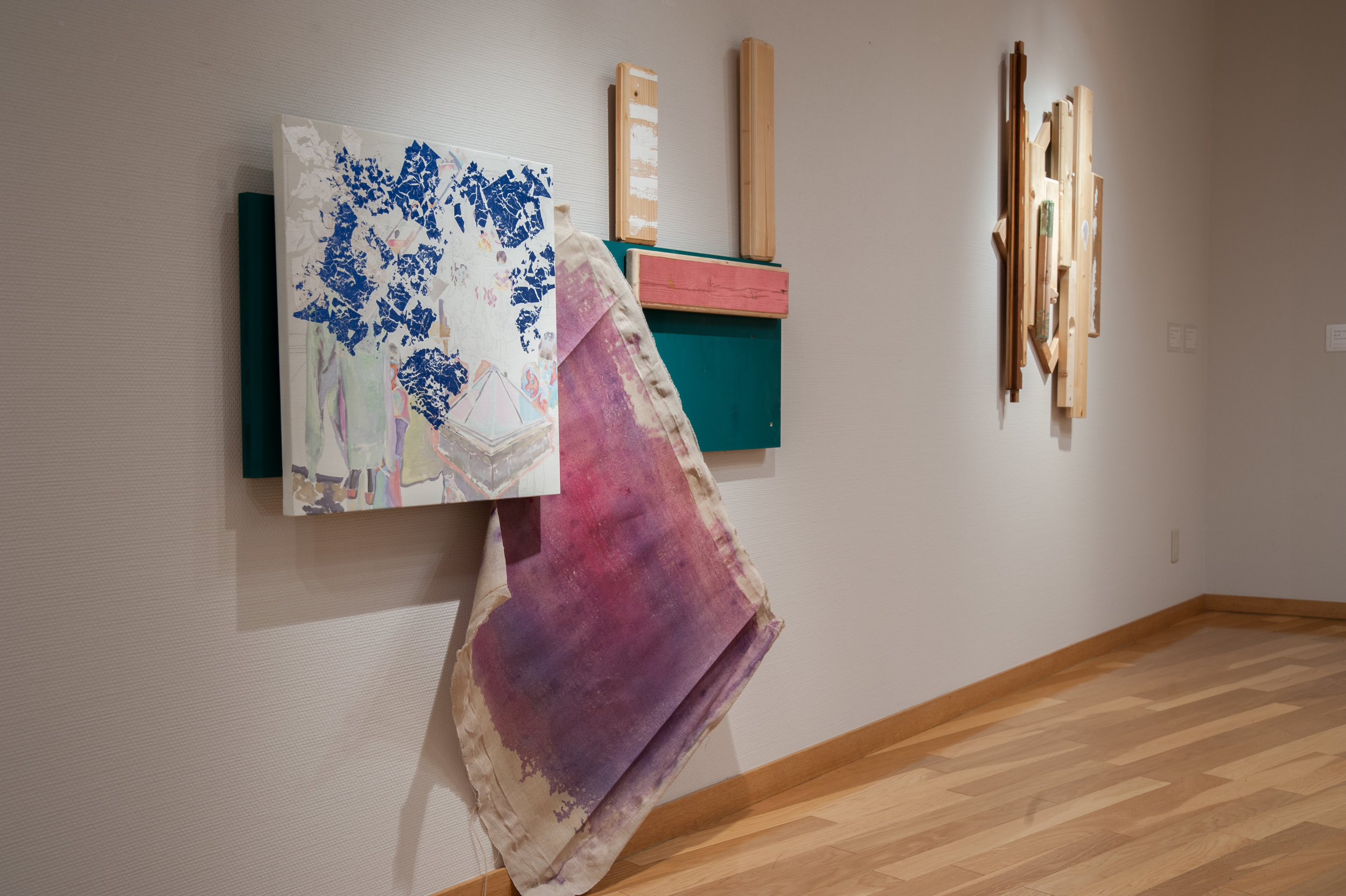
Haru no Niwa (2018)
(Solo Installation in a Group Show)
on24 February through 3 June
atNakata Museum
Participating Artists:
Yutaka Inagawa / Tamaki Ono / Martina della Valle / Masanori Mimasu

The installation treats painting as a porous body rather than a sealed façade. Unfinished canvases—graphite vectors exposed, primer still breathing—behave like membranes, absorbing foreign matter as they negotiate their own becoming. Circling them are hybrid agents: timber slivers glazed in metal leaf, resin‑hardened gloves that read as the moulting of the artist’s hands, excised letterforms adrift from language, and printed montages that hover between image and residue. Each element speaks its own dialect, yet none is allowed to crystallise; the entire room remains in a state of suspended translation.
Spatially, the exhibition unfolds in concentric argument. Wall‑bound works stage the possibility of a painting that never closes, recruiting stretcher fragments, unstretched canvas, and even a dismantled bed‑head to play host to incomplete images. Near the threshold, a glass vitrine condenses the show’s material alphabet: aligned gloves, machined timbers, letterform negatives, stray montage shards—an abstract lexicon previewing the negotiations to come. At the centre, a lone table serves as geological cutaway, lifting collage layers above an illusory ground plane while exposing a shadow shelf below, a notional substratum where painterly debris continues to settle.
Together these zones form a single speculative apparatus. They ask how far a painting can dilate before it forfeits its name, how much incompleteness it can sustain before coherence dissolves, and whether the medium’s authority survives contact with the unruly materials that both animate and undermine it. In withholding closure, Inagawa proposes a more generous completeness—one that remains hospitable to contingency, allowing the digital, the physical, and the imaginary to renegotiate their borders in perpetuity.
本インスタレーションは、絵画を密閉された平面ではなく、外部と通じ合う多孔質の〈身体〉として再考する試みである。グラファイトの投影線や下地のジェッソが露わなまま残る小さな正方形キャンバスは、生成途上の膜となり、周囲の異物を取り込みながら自らの輪郭を揺るがせる。その周囲には、金属箔で化粧された木片、作家の手の抜け殻のような樹脂硬化グローブ、文字を切り抜いたあとに残る板材のネガ(文字の“負形”)、漂流するプリント・モンタージュが巡る。いずれも固有の語法を携えつつ決して安定せず、空間全体を「未完の翻訳状態」にとどめる。
展示は三層構造の思考実験として展開する。壁面では、ストレッチャー断片や木枠から剥がされたキャンバス、解体されたベッドヘッドなどが「閉じきらない絵画」の肉体を組成し、イメージとオブジェの境界を溶解させる。入り口付近のガラスショーケース内部には、樹脂化したグローブや加工木材、文字の負形、漂うモンタージュ片が凝縮され、素材のアルファベット──展示全体の語彙集──を提示する。中央のテーブルは地質断面図のように置かれ、コラージュ片とプリント層を〈地表〉と〈地下〉に折り重ねることで、絵画(ペインティング)が孕む多層的な階層を可視化する。
こうして空間は、解決済みのアートピースの集合ではなく、ひとつの思索装置として立ち上がる。絵画はどこまで拡張すればなお絵画たり得るのか。どれほどの未完を抱えていられるのか。絵画の論理は、それを支えながら同時に攪乱もする物質世界との接触に耐え得るのか。稲川は終止符を故意に先延ばしにし、偶発性に開かれた「寛容な完成」を提案する。その内部でデジタル/フィジカル/イマジナリーは絶えず境界を再交渉し、揺らぎ続ける。



Shaky Dspm_01, 2018, 159x104cm, photo: Kiyohito Mikami

Iridescent Shenanigans01, 2018, 154x130cm, photo: Kiyohito Mikami

photo: Kiyohito Mikami

Concocting Disavowal, 2018, 117x91.5cm, photo: Kiyohito Mikami

Itinerant Sheaths, 2018, 98x75cm, photo: Kiyohito Mikami

Iridescent Shenanigans, 2018, 182x92cm





